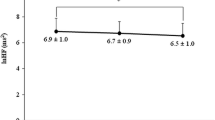Abstract
It has been suggested that the dive reflex (elicited by face immersion in water with breath-hold) may be employed to induce vagally-mediated bradycardia in individuals with paroxysmal atrial tachycardia. However, in several cases the use of this reflex is reported to have led to exacerbation of the cardiac dysfunction. Examination of heartrate and EKG T-wave amplitude changes during the dive in healthy, college-aged individuals indicated that warming the water (10° through 20° C to 40° C) decreased the bradycardia, but did not alter theattenuation (approximately 100 μv) of the T-wave. The latter effect was taken to indicate that sympathetic activity, as indexed by T-wave amplitude, was not reduced by increases in water temperature. On the other hand, a 90° head-up to head-down body tilt produced a bradycardia response of some 30 bpm as well as a T-wave amplitudeincrease (sympathetic withdrawal) in the order of 100 μv. These data suggest that individuals who exhibit symptoms of ventricular sympathetic irritability may be adversely affected by the dive maneuver, regardless of water temperature. The body-tilt induced reflex in such individuals may thus be more appropriate given the large-magnitude bradycardia and absence of T-wave attenuation. At the present, however, the body-tilt preparation has been used only with healthy normal subjects, so this suggestion remains to be directly tested.
Similar content being viewed by others
References
Andersen, H. T. Physiological adaptation in diving vertebrates.Physiological Review, 1966,46, 212–243.
Bamford, M. F. M., and Pickering, D. Use of diving reflex in an infant with supraventricular tachycardia. Letter to the Editor.Archives of Disease in Childhood, 1978,53, 520.
Condry, P., Jain, A., Marshall, R., and Bosyer, A. Ventricular tachycardia and diving reflex. Letter to the Editor.Lancet, 1975,2, 1263.
Furedy, J. J. Teaching self-regulation of cardiac function through imaginational Pavlovian and biofeedback conditioning: remember the response. In N. Birbaumer and H. D. Kimmel (Eds.),Biofeedback and Self Regulation, New York: Erlbaum, 1979.
Furedy, J. J., and Klajner, F. Imaginational Pavlovian conditioningof large-magnitude cardiac decelerations with tilt asUS. Psychophysiology, 1978,15, 538–543.
Furedy, J. J., and Poulos, C. X. Heart-rate decelerative Pavlovian conditioning with tilt as UCS: towards behavioral control of cardiac dysfunction.Biological Psychology, 1976,4, 93–105.
Gooden, B. A., Holdstock, G., Hampton, J. R. The magnitude of the bradycardia induced by face immersion in patients convalescing from myocardial infarction.Cardiovascular Research, 1978,12, 239–242.
Heslegrave, R. J., and Furedy, J. J. Sensitivities of HR and T-wave amplitude for detecting cognitive and anticipatory stress.Physiology and Behavior, 1979,22, 17–23.
Hoffman, B. F. Neural influences on cardiac electrical activity and rhythm. In W. C. Randall (Ed.).Neural regulation of the heart. New York: Oxford University Press, 1977, p. 309.
Hurwitz, B., and Furedy, J. J. The human dive reflex: an experimental topographical and physiological analysis. Abstract.Psychophysiology, 1978,16, 192.
Mathew, P. K. Treatment of Paroxysmal Atrial tachycardia by diving reflex. Letter to Editor.Lancet, 1978,1, 510.
Matyas, T. A., and King, M. G. Stable T-wave effects during improvement of heart rate control with biofeedback.Physiology and Behavior, 1976,16, 15–20.
Morrison, J. M., and Furedy, J. J. A response-topography analysis of the effect of water temperature on cardiovascular components of the dive reflex. Abstract.Psychophysiology, 1979,17, 317.
Szalai, J. P. The effective physiological onset and durational aspects of the negative body tilt UCS in the human Pavlovian conditioning of the cardiac functions. Unpublished Master’s Thesis, University of Toronto, 1977.
Wildenthal, K., Leshin, S. J., Atkins, J. M., and Skelton, C. L. The diving reflex used to treat paroxysmal atrial tachycardia.Lancet, 1975,1, 12–14.
Author information
Authors and Affiliations
Rights and permissions
About this article
Cite this article
Arabian, J.M., Furedy, J.J., Morrison, J. et al. Treatment of PAT. Pav. J. Biol. Sci. 18, 88–93 (1983). https://doi.org/10.1007/BF03001860
Issue Date:
DOI: https://doi.org/10.1007/BF03001860



